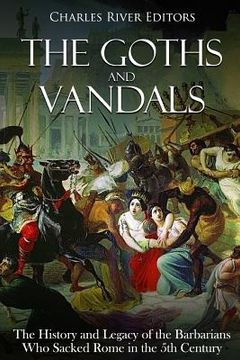The Goths and Vandals: The History and Legacy of the Barbarians Who Sacked Rome in the 5th Century CE (en Inglés)
Reseña del libro "The Goths and Vandals: The History and Legacy of the Barbarians Who Sacked Rome in the 5th Century CE (en Inglés)"
*Includes pictures *Includes online resources and a bibliography for further reading The birth of Europe as people know it today was hardly an easy and effortless process. The Old World was reshaped by centuries of continuous wars, raids, and the falls and rises of empires. The most turbulent of these events happened at the beginning of the Middle Ages, from the 3rd-7th centuries CE. This was the time when the old slave society gave way to the feudal system that marked the latter Middle Ages, and it was also a period of battles between the Roman Empire and various barbarian peoples. The Roman Emperors waged wars, made and broke alliances, and bribed and negotiated with chieftains of various "barbarian" tribes to preserve the territorial integrity of their Empires, but the razor-edge division between the civilized world of the Romans and that of the "savages" that threatened their borders was dulling with every decade. In fact, the constant need for army recruits swelled the Roman legions with barbarian foederati, a phenomenon that forced both the Romans and Byzantines to use a very subtle way of playing the barbarian tribes against each other via diplomatic schemes and bountiful rewards. A new religion was also taking root: Christianity became a reason for both unification and division, as different people adopted different variations of its teachings. It is true that the Vandals sacked Rome in 455 AD, but even that act was a unique historical accomplishment in itself as they were only the third people to inflict such destruction on one of the world's greatest cities. Despite living on the lawless marchlands of the Roman Empire, the Vandals were able to establish two different kingdoms, and introduce a fairly complicated code of royal succession, that gave stability to their people for some time. The Vandals also proved to be an extremely clever people in their use of violence and war, as they rarely engaged in violence for its own sake. They also often employed clever tactics on the battlefield to defeat the larger and more sophisticated armies of the Romans, and later, the Byzantines. It goes without saying that the Goths played an integral part in the history of Europe during this time, and they remain among the most notorious and controversial groups in history. By the 4th century CE, The Goths were among the prominent barbarian groups who became a threat to the Roman Empire, but they also had contacts with the Romans well before then, and they even traded for awhile. The two branches of the Goths that are best known, the Visigoths and Ostrogoths, stared down the Roman Empire as it neared its collapse and supplanted it with a kingdom in Italy in the 5th and 6th centuries respectively. The Visigoth leader Alaric and the Ostrogoth leader Theodoric are still well-known names due to their deeds and reigns in Europe. In addition to the Visigoths' conflicts with Rome, the ancient author Jordanes has helped keep the Goths relevant with his seminal work The Origin and Deeds of the Goths, which traces the group's history all the way back to about 1500 BCE and covers their migrations and wars on the European continent. While some still discount Jordanes' work as outright fiction, most historians still believe that it's a valuable historical work, and they continue to rely on it in attempts to study and trace the history of the Goths and their various branches over time. The Goths and Vandals: The History and Legacy of the Barbarians Who Sacked Rome in the 5th Century CE examines both groups, and how their actions in the 5th century helped bring about the end of the Western Roman Empire.

